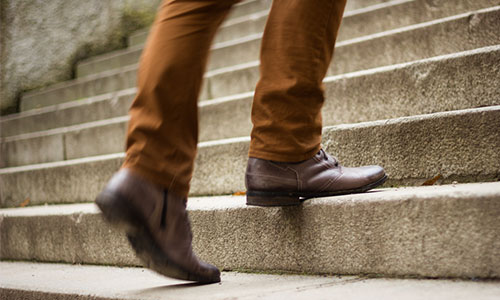How to protect and strengthen your hips and knees
- Overview
Hip and knee joints need to function well to perform the most basic and everyday movements, including standing, walking, running, bending and stretching.
Wear and tear can happen naturally over time and in some cases surgery, including hip resurfacing, hip replacements and knee replacements, may be the best course of action. But there are things you can do to reduce your risk of osteoarthritis and get the best performance out of your hips and knees, perhaps for many years to come.
We asked our orthopaedic, exercise and nutritional experts for their tips on how to look after your joints.
Lighten the load
Orthopaedic Surgeon, Mr Peter Gallacher from Nuffield Health Shrewsbury Hospital, says:

There are many good reasons to lose weight, and looking after your joints is one of them. Hips and knees are load-bearing joints. The heavier you are, the more load they have to bear and the faster they'll wear out. Your hips or knees may even hurt when walking if you carry excess weight.
You don't have to lose much to make a big difference. For example, when you walk up or down a flight of stairs, the load on your knees is roughly seven times your body weight. If you're overweight, that adds up very quickly. But losing just one stone will take around seven stone off your knee joint with every step.
Read Mr Gallacher's 4 signs you may need a knee replacement article.
Eat healthily

Nutritional Therapist Mary Cotter says:
Like a machine with moving parts, our body needs oil to keep joints lubricated and healthy. Eat oily fish rich in omega-3 fats like salmon and mackerel twice a week. Omega-3 has been linked to reduced joint pain and morning stiffness.
Vitamin E has anti-inflammatory properties and healthy levels have been linked to lower risk of joint and bone cell damage*. You'll get plenty by adding avocado, sunflower seeds, nuts and even lobster to your diet.
Antioxidants are thought to slow the progression of arthritis inflammation. They're found in brightly-coloured berries, blueberries are particularly rich in antioxidants.
Read Mary's healthy joints recipe.
Exercise – but take it easy
Senior Wellbeing Personal Trainer Haydn Ward says:
Excessive exercise can cause your joints to wear out prematurely. Many elite sportsmen and women find they have problems with their joints earlier in life than less active people, but that shouldn't put you off. The benefits of regular exercise far outweigh the negatives. Building strong, flexible muscle around your hips and knees means the joints don't have to do all the work by themselves.
Low-impact activities such as swimming, brisk walking or cycling help to mobilise the joints, resistance training can help to build strength, and stretches can improve your flexibility. All of this can make a big difference to your ability to prevent and recover from injury, as well as reduce wear and tear on the joints. Depending on the level of your hip or knee pain, classes offered at our gyms, such as yoga, Pilates and aqua aerobics can be beneficial.
Exercises to strengthen your knees
Here are 9 gentle exercises and stretches to help support your hips and knees – the first three are taken from our Joint Pain Programme.
Remember to warm up with some cardio first, and cool down with stretches afterwards. If you feel any pain, find an easier alternative. If you’ve been diagnosed with or experience osteoarthritis symptoms, check with your healthcare professional before performing these exercises.
A physiotherapist or personal trainer will be able to advise you on the best bespoke exercise plan for you.
1. Squat
- Stand with your feet shoulder-width apart and slightly turned out. Keep your back flat and chest proud
- Push your bum back and bend your knees, as if you're sitting back into a chair. Make sure your heels stay on the ground – you should be able to see your toes the whole time
- If this is too challenging, you can add in a chair to sit on to. Or if it’s too easy, try holding a weight at your chest.
2. Step up
- Place a step next to something you can hold on to for balance (or you could even use stairs if you have them and hold on to the bannister)
- Place one foot on the step, holding on if you need to, and raise the other leg – bending your knee to a 90-degree angle. Hold for a second before returning the foot to the ground and repeating on the other side
- If this is too difficult, try toe taps instead. Or if you'd like a more challenging alternative, add a toe tap to your step up.
3. Leg extension
- Tie a resistance band to the base of a chair leg. Sit down and tie the other end to your ankle, with tension in the band
- Keep your hands on the side of the chair and extend the leg as far as the knee will allow. Bring the leg slowly back to its original position and repeat
- For a simpler exercise, remove the band. Or for a challenge, use a suspension device like the TRX to perform a supported lunge.
4. Banded walks
- Grab that resistance band again and it loop around your legs – either just below or just above the knees
- Starting with your feet hip-width apart, take a controlled step to one side. Once the foot lands, control the other foot next to it, so they're hip-width apart again
- Take five steps in that direction, then immediately five steps back to your start position. Rest for one minute, and then repeat two to three times.
5. Standing hamstring curls
- Stand straight with your knees one to two inches apart – hold on to a chair for support if you need it
- Slowly lift your right heel behind your body at 90 degrees. Keep your straight leg slightly bent to avoid locking it
- Hold for five seconds then slowly lower to the floor. Repeat two more times, before swapping legs.
6. Quad stretch
- From kneeling, place one foot out in front, knee over ankle. From there, tuck your tail to stretch the kneeling leg. Hold for 15–20 seconds and do this three or four times on each leg
- To deepen the stretch, raise your back foot off the ground, hold onto your ankle and pull it towards your bottom until you feel the stretch in your quads – make sure you cushion your knee if this is painful
- If you can’t do this, for example if you have arthritis, you can do the same thing by standing on one leg and pulling your other ankle towards your bottom.
7. Leg lifts
- Laying flat on the floor, place you hands under the arch in your back in a diamond shape. Keeping the knees and feet together, lift the legs off the floor
- Slowly and with control, lift to a 45-degree angle, before controlling your legs to the floor. Aim to complete between 5–10 reps, rest for one minute, and then repeat
- If keeping the legs straight is too strenuous, you can bend the knees and aim to tuck your knees up to your chest, keeping knees and feet together. Don’t perform this exercise if you have osteoporosis or a back-compression fracture.
8. Hip bridge
- Laying in the 'sit up' position with your knees and feet together, press through your feet and raise your hips off the floor as high as you can
- Hold for five seconds, then return to the floor. Repeat five times, then rest for one minute, then repeat the set again
- If this is too easy, when you raise your hips, extend one leg out straight and hold for three to five seconds. Return to the floor and repeat with other leg.
9. Figure 4 glute stretch
- Stay in that same 'sit up' position With your feet flat on the floor and place one ankle across the other knee to stretch the glute
- You can increase the stretch by pulling the supporting leg towards you
- Hold for 20 seconds, then release and repeat on other side. Repeat two to three times.
Free Joint Pain Programme for strengthening joints
Our Joint Pain Programme is an innovative 6-month course that features 12 weeks of lifestyle advice and exercise sessions lead by a trained recovery specialist. The programme has helped thousands of people build their joints up after injury and reverse the onset of chronic pain.
The programme is completely free and has helped thousands of people learn more about their body and find relief from the pain and symptoms associated with arthritis and joint pain.
- Sound useful? Click here to learn more about our free Joint Pain Programme.
Also explore our joint health advice hub
Related Video: Beginner Knee Rehab with Zahra
Thanks, this has really helped. John
Brilliant, thank you. Barbara
This video is part of our on-demand 24/7 content. To view more videos and subscribe to our 24/7 virtual gym click here.
Last updated Monday 25 September 2023
First published on Thursday 25 February 2016
